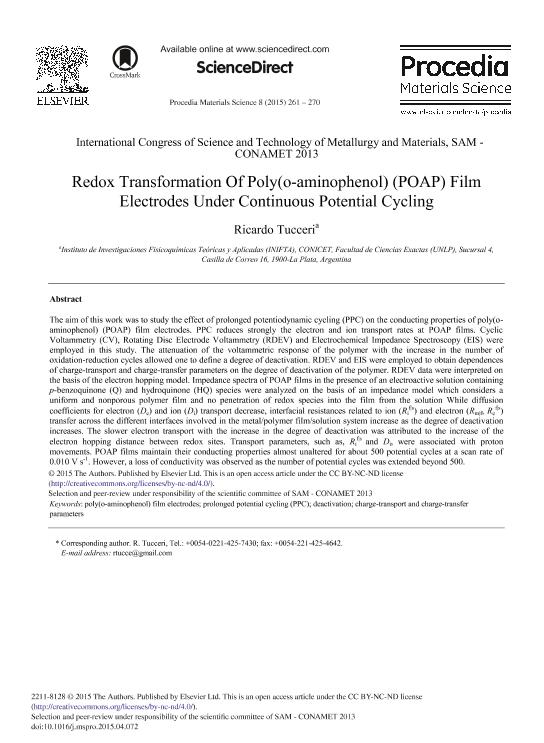Mostrar el registro sencillo del ítem
dc.contributor.author
Tucceri, Ismael Ricardo

dc.date.available
2016-04-04T20:43:47Z
dc.date.issued
2015-06
dc.identifier.citation
Tucceri, Ismael Ricardo; Redox transformation of poly(o-aminophenol) (POAP) under continuous potential cycling; Elsevier; Procedia Materials Science; 8; 6-2015; 261-270
dc.identifier.issn
2211-8128
dc.identifier.uri
http://hdl.handle.net/11336/5041
dc.description.abstract
The aim of this work was to study the effect of prolonged potentiodynamic cycling (PPC) on the conducting properties of poly(oaminophenol) (POAP) film electrodes. PPC reduces strongly the electron and ion transport rates at POAP films. This effect is called here deactivation. Cyclic Voltammetry (CV), Rotating Disc Electrode Voltammetry (RDEV) and Electrochemical Impedance Spectroscopy (EIS) were employed in this study. The attenuation of the voltammetric response of the polymer with the increase in the number of oxidation-reduction cycles allowed one to define a degree of deactivation. RDEV and EIS were employed to obtain dependences of charge-transport and charge-transfer parameters on the degree of deactivation of the polymer. RDEV data were interpreted on the basis of the electron hopping model. Impedance spectra of POAP films in the presence of an electroactive solution containing p-benzoquinone (Q) and hydroquinone (HQ) species were analyzed on the basis of an impedance model which considers a uniform and nonporous polymer film and no penetration of redox species into the film from the solution While diffusion coefficients for electron (De) and ion (Di) transport decrease, interfacial resistances related to ion (Ri f s) and electron (Rm f, Ref s) transfer across the different interfaces involved in the metal/polymer film/solution system increase as the degree of deactivation increases. The slower electron transport with the increase in the degree of deactivation was attributed to the increase of the electron hopping distance between redox sites. Transport parameters, such as, Rif s and Di, were associated with proton movements. POAP films maintain their conducting properties almost unaltered for about 500 potential cycles at a scan rate of 0.010 V s-1. However, a loss of conductivity was observed as the number of potential cycles was extended beyond 500.
dc.format
application/pdf
dc.language.iso
eng
dc.publisher
Elsevier

dc.rights
info:eu-repo/semantics/openAccess
dc.rights.uri
https://creativecommons.org/licenses/by-nc-nd/2.5/ar/
dc.source
International Congress of Science and Technology of Metallurgy and Materials, SAM - CONAMET 2013
dc.subject
Poly(O-Aminophenol) Film Electrodes
dc.subject
Prolonged Potential Cycling (Ppc)
dc.subject
Deactivation
dc.subject
Charge-Transport And Charge-Transfer Parameters
dc.subject.classification
Físico-Química, Ciencia de los Polímeros, Electroquímica

dc.subject.classification
Ciencias Químicas

dc.subject.classification
CIENCIAS NATURALES Y EXACTAS

dc.title
Redox transformation of poly(o-aminophenol) (POAP) under continuous potential cycling
dc.type
info:eu-repo/semantics/article
dc.type
info:ar-repo/semantics/artículo
dc.type
info:eu-repo/semantics/publishedVersion
dc.date.updated
2016-05-06 15:52:43.262787-03
dc.journal.volume
8
dc.journal.pagination
261-270
dc.journal.pais
Países Bajos

dc.journal.ciudad
Amsterdam
dc.description.fil
Fil: Tucceri, Ismael Ricardo. Consejo Nacional de Investigaciones Científicas y Técnicas. Centro Científico Tecnológico la Plata. Instituto de Investigaciones Fisicoquímicas Teóricas y Aplicadas; Argentina. Universidad Nacional de La Plata; Argentina
dc.journal.title
Procedia Materials Science
dc.relation.alternativeid
info:eu-repo/semantics/altIdentifier/url/http://www.sciencedirect.com/science/article/pii/S2211812815000735
dc.relation.alternativeid
info:eu-repo/semantics/altIdentifier/doi/10.1016/j.mspro.2015.04.072
dc.relation.alternativeid
info:eu-repo/semantics/altIdentifier/doi/http://dx.doi.org/10.1016/j.mspro.2015.04.072
Archivos asociados
